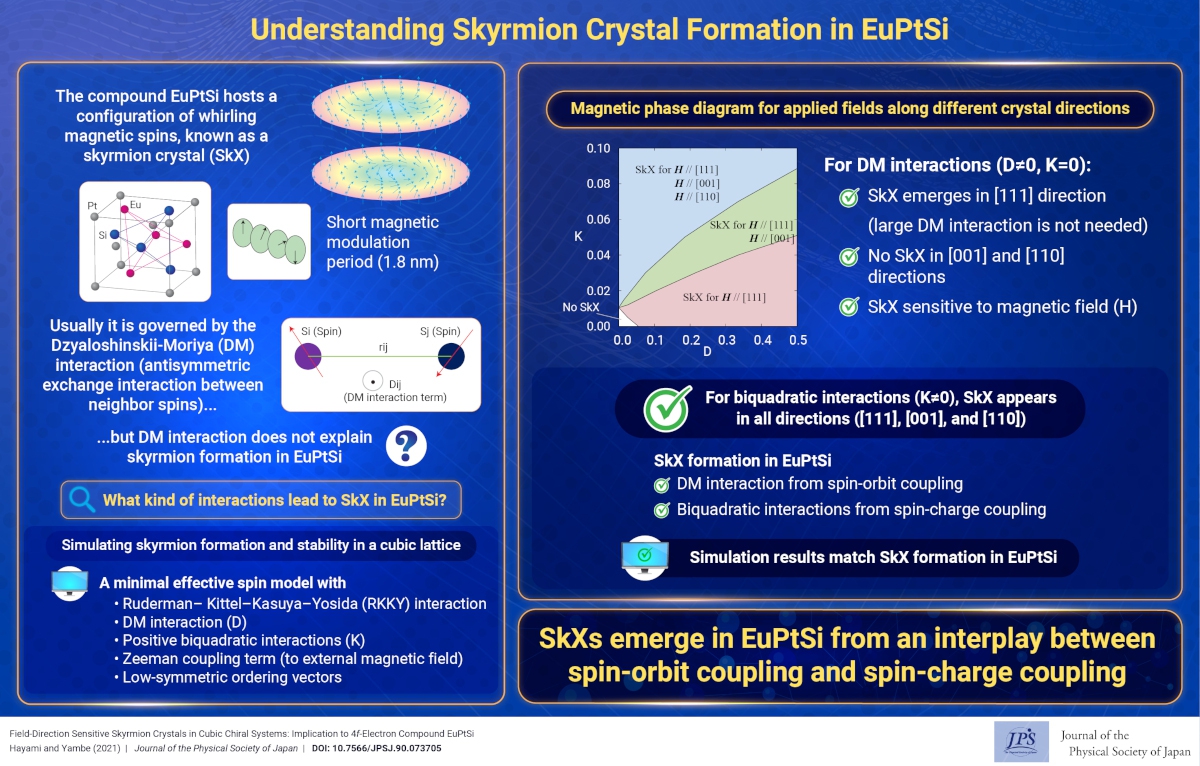Understanding Skyrmion Crystal Formation in EuPtSi
© The Physical Society of Japan
This article is on
Field-Direction Sensitive Skyrmion Crystals in Cubic Chiral Systems: Implication to 4f-Electron Compound EuPtSi
(JPSJ Editors' Choice)
J. Phys. Soc. Jpn. 90, 073705 (2021).
We theoretically demonstrate that the interplay between the spin-charge and spin-orbit couplings in itinerant magnets stabilizes field-direction sensitive, short-period skyrmions. Our results can aid in engineering short-period skyrmions.

Magnetic skyrmions with swirling topological spin textures are of significant interest owing to their peculiar magnetic, transport, and optical properties. In magnetic materials, skyrmions usually appear in a periodically ordered state, which is referred to as the skyrmion crystal (SkX). The SkX can be considered as a multiple-q order described by the superposition of multiple spiral waves. The SkX was originally discovered in 2009 in d-electron compounds like MnSi, where the Dzyaloshinskii–Moriya interaction plays an important role. Recently, SkXs have been observed in centrosymmetric magnets via other mechanisms, such as frustrated exchange interactions and/or multiple-spin interactions in itinerant magnets. The resulting difference due to the individual origins appears in the magnetic modulation period of the SkXs, with the original mechanism usually leading to much longer magnetic periods than those of the latter ones. Specifically, a small skyrmion induces a large emergent magnetic field, and hence engineering small skyrmions is relevant for future spintronics applications, as they may potentially aid in realizing energy-efficient devices based on high density topological objects.
The itinerant chiral antiferromagnet EuPtSi is the first f-electron compound with a noncentrosymmetric lattice structure found to host a SkX with a small magnetic period. The origin of the SkX in EuPtSi is not explained by the conventional mechanism based on the Dzyaloshinskii–Moriya interaction, as the magnetic periods and the magnetic-field-direction dependencies of the SkXs are different from those found in other noncentrosymmetric magnets. Therefore, we need to consider other mechanisms that have not yet been theoretically clarified. Understanding the origin of short-period SkXs in noncentrosymmetric itinerant magnets found in EuPtSi is crucial in enabling small skyrmion engineering for practical applications.
In this study, we theoretically investigated the origin of SkXs in f-electron compounds by constructing a new model based on EuPtSi. We discovered the following two important elements in inducing a field-direction sensitive SkX with a small magnetic period: (1) the multiple-q superpositions of the spirals with low-symmetric ordering vectors and (2) the synergy between the long-range Dzyaloshinskii–Moriya interaction arising from the spin-orbit coupling and the biquadratic interaction arising from the spin-charge coupling in itinerant magnets. We demonstrated that the theoretical model which satisfies the two conditions accurately describes the SkX physics in EuPtSi through unbiased annealing simulations. Our study provides a reference for both engineering short-period SkXs and for exploring further skyrmion-hosting materials in noncentrosymmetric itinerant magnets.
(Written by Satoru Hayami on behalf of all authors.)
Field-Direction Sensitive Skyrmion Crystals in Cubic Chiral Systems: Implication to 4f-Electron Compound EuPtSi
(JPSJ Editors' Choice)
J. Phys. Soc. Jpn. 90, 073705 (2021).
Share this topic
Fields
Related Articles
-
Variety of Mechanically Induced Spin Currents in Rashba Systems
Electronic transport in condensed matter
Magnetic properties in condensed matter
Structure and mechanical and thermal properties in condensed matter
2024-3-22
Various types of spin currents, including unconventional types, are generated in Rashba spin-orbit coupled systems by dynamic lattice distortions associated with, for example, surface acoustic waves.
-
Current Melt Frozen Electrons
Dielectric, optical, and other properties in condensed matter
Magnetic properties in condensed matter
2024-1-15
The origin of the current-induced insulator-to-metal transition of samarium monosulfide was explained by the 4f−5d hybridization observed using optical reflectivity and photoelectron spectroscopies.
-
Towards Uncovering the Hidden Order of URu2Si2 Phase Transition
Magnetic properties in condensed matter
Electronic structure and electrical properties of surfaces and nanostructures
2024-1-11
We propose a chiral charge as the hidden order parameter in URu2Si2 and present experiments to detect it by focusing on breakings of mirror and inversion symmetries at the local uranium ion.
-
Magnetic Excitation in S = 1/2 Antiferromagnetic Chain CsCoCl3 with Ising-Like Exchange Interaction
Magnetic properties in condensed matter
2023-11-13
The results of high-field electron spin resonance measurements in the millimeter-wave to terahertz region reveal unconventional magnetic excitation in S = 1/2 one-dimensional antiferromagnets.
-
Strange Elastic Anomalies with Ultraslow Dynamics around Magnetic Critical Endpoint
Structure and mechanical and thermal properties in condensed matter
Magnetic properties in condensed matter
2023-11-2
Near the magnetic critical endpoint of UCoAl, peculiar elastic anomalies exhibiting exotic ultraslow dynamics arising from electric quadrupoles are indicated. Combining this with diverse fluctuations, intriguing phenomena and exotic ground states are expected.
